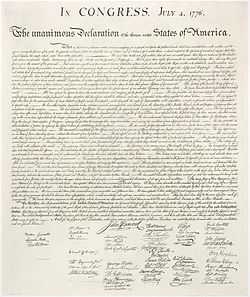William Ellery
| William Ellery | |
|---|---|
 | |
| 31st Deputy Governor of the Colony of Rhode Island and Providence Plantations | |
| In office 1748–1750 | |
| Governor | William Greene |
| Preceded by | William Robinson |
| Succeeded by | Robert Hazard |
| 23rd Chief Justice of the Rhode Island Supreme Court | |
| In office June 1785 – May 1786 | |
| Preceded by | Paul Mumford |
| Succeeded by | Paul Mumford |
| Personal details | |
| Born | December 2, 1727 Newport, Rhode Island |
| Died | February 15, 1820 (aged 92) Newport, Rhode Island |
| Occupation | Lawyer |
| Signature | |
William Ellery (1727-1820) was a signer of the United States Declaration of Independence as a representative of Rhode Island. In 1764, the Baptists consulted with Ellery and the Congregationalist Reverend Ezra Stiles on writing a charter for the college that became Brown University. However, Ellery and Stiles attempted to give control of the college to the Congregationalists, but the Baptists withdrew the petition until it was rewritten to assure Baptist control. Neither Ellery nor Stiles accepted appointment to the reserved Congregationalist seats on the board of trustees .[1]
Biography
The second son of William Ellery Sr. and Elizabeth Almy, William Ellery was born in Newport on December 2, 1727. He received his early education from his father, a merchant and Harvard College graduate. In 1747 William Ellery graduated from Harvard College where he had excelled in Greek and Latin. Ellery returned to Newport where he worked first as a merchant, next as a customs collector, and then as Clerk of the Rhode Island General Assembly. Ellery started practicing law in 1770 at the age of 43 and became active in the Rhode Island Sons of Liberty.
After Samuel Ward's death in 1776, Ellery replaced Ward in the Continental Congress. Ellery was among the fifty-six signers of the Declaration of Independence in 1776. Ellery also served as a judge of the Supreme Court of Rhode Island and by 1785 he had become an abolitionist. He was the first customs collector of the port of Newport under the Constitution, serving there until his death. Ellery was an active worshipper at the Second Congregational Church of Newport.[2][3] After his death in 1820 at age 92, Ellery was buried in Common Burying Ground in Newport.[4]
Family and legacy
Ellery married Ann Remington of Cambridge, Massachusetts in 1750. She was the daughter of Judge Jonathan Remington. She died in 1764 in Cambridge and was buried there. He remarried in 1767 to Abigail Cary.
His descendants include Ellery Channing, William Ellery Channing, Richard Henry Dana, Sr., Edie Sedgwick, Kyra Sedgwick, James Ellery, Gary Ellery, Jadriene M. Ellery, William Ellery Roberts, Manon Roberts-Gowans. Ellery Avenue in Middletown, Rhode Island is named in his honor. He had 19 children and was married twice in his lifetime. He died on February 15, 1820.
William Ellery is the namesake of the town of Ellery, New York.[5]
Images
-

Ellery's tomb at Common Burying Ground and Island Cemetery in Newport
-

William Ellery's grave inscription
-

Site of Ellery's house in Newport on Thames Street near his burial site
-

William Ellery by Ole Erekson, engraver
References
- ↑ Historical Catelogue of Brown University,Providence: Brown University, 1914.
- ↑ Charles Francis Adams, The works of John Adams, Volume 8 (Little, Brown, 1853), pg. 61 quoting "William Ellery and others to John Adams,"Newport RI 26 May 1783 http://books.google.com/books?id=0JYsAAAAYAAJ&source=gbs_navlinks_s
- ↑ http://www.adherents.com/gov/Founding_Fathers_Religion.html
- ↑ Charles Augustus Goodrich "Lives of the Signers of the Declaration of Independence," (T. Mather, New York: 1840) pg. 153
- ↑ Gannett, Henry (1905). The Origin of Certain Place Names in the United States. Govt. Print. Off. p. 117.
External links
| |||||||
| |||||||
Template:Rhode Island in the American Revolutionary War
|

